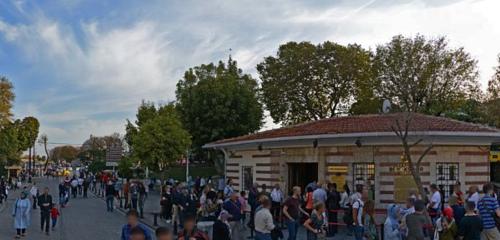Search
Directions
The Basilica Cistern
Rating 5.0
2393 ratings
Add photo or video
530 more
Address
Business hours
Open until 11:50 PM
Schedule
Directions
Sirkeci
660 m
2
Show parking info

Panorama
Customer traffic and business hours
10:00Usually moderately busy
Mon
Tue
Wed
Thu
Fri
Sat
Sun
Similar places nearby
Rating 5.0
2393 ratings
Rate this place
849 reviews
By default
orukayu
Level 27 Local Expert
Entrance is paid. 80 TL for adult, 30 TL for students. Expect a queue of approximately half an hour.
Basilica Cistern, also known as the Basilica, built by Byzantine Emperor Justinian I (527-565) in 532, attracts attention with its seemingly countless marble columns rising from the water. The cistern, where 7 thousand slaves were employed during construction, was completed in 38 years. This giant structure, which covers a rectangular area with a length of 140 meters and a width of 70 meters, has the capacity to store approximately 100 thousand tons of water. There are 336 columns inside the cistern, each 9 meters high. 98 of these columns reflect the Corinthian style, and some reflect the Doric style. The two Medusa Heads used as pedestals under two columns (one placed sideways and the other upside down) are masterpieces of Roman Period sculpture art and are the structures that attract the most attention of those who visit the cistern.
Due to their religious beliefs, the Ottoman people preferred flowing water over stagnant water. For this reason, the cistern was used for irrigation for a long time after the conquest of Istanbul and remained idle when the Ottoman Empire started to establish and use its own water facilities. P. Gyllius, of French origin, came to Istanbul, to the palace of Suleiman the Magnificent, in 1544, representing the King of France, François I, in order to collect valuable manuscripts for the library of the Kingdom of France. Gyllius is so fascinated by Istanbul that he says, "All cities in the world are doomed to die, but Istanbul will live as long as people exist."
While wandering around Hagia Sophia, Gyllius hears that people get water from the wells inside their houses and even fish. In fact, Gyllius is interested in ichthyology, the science of fish. Perhaps the subject of “fishing” impressed him and thus he asked: “What is there in this area with water underneath?” He thought and did his research. In the walled courtyard of a large wooden house known to the public, he sees stone steps leading underground. Taking a torch in his hand, he goes down these steps. He encounters a huge cistern below. In the following days, he descends to this cistern again and again and begins to wander on the water in a boat. He takes the measurements of the cistern and identifies the columns. He visited many important historical monuments of Istanbul until 1547, when he stayed in the city, and wrote very important books about the Bosphorus and the monuments he visited. These writings were published by his nephew in 1561-62, after Gyllius' sudden death.
Although it is not known exactly where and for what purpose the Medusa heads used as pedestals under the columns in the cistern were brought, there are some opinions about this:
According to a legend, Medusa is one of the three Gorgona sisters, female monsters of the underworld in Greek mythology. Snake-headed Medusa has the power to turn those who look at her to stone.
According to one view, Gorgona paintings and sculptures were used to protect large buildings and special places at that time. This is why the head of Medusa was placed in the cistern.
According to another rumor, Medusa; She was a girl who was proud of her black eyes, long hair and beautiful body. Medusa loved Zeus' son Perseus. Meanwhile, Athena also loved Perseus and was jealous of Medusa. That's why Athena turned Medusa's hair into snakes. Now everyone Medusa looked at turned into stone. Later, Perseus cut off Medusa's head and had the opportunity to defeat many of his enemies by taking advantage of her power. Based on this, the Head of Medusa was engraved on sword hilts in Byzantium and placed upside down on column bases (to prevent ministers from being cut into stone).
According to another rumor, Medusa looked sideways and turned herself into stone. That's why the sculptor who made the statue here made Medusa in three different positions according to the reflection angles of light.
3
Anita Swenson
Level 3 Local Expert
Very lovely place but expensive for tourists and we waited 1 hour to go into.
Андрей
Level 7 Local Expert
Beautiful place
3